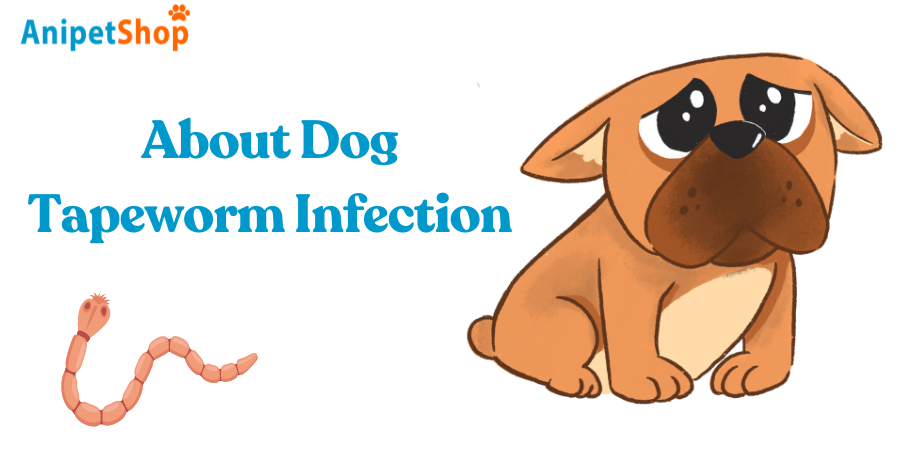About Dog Tapeworm Infection
Dogs are more than just pets; they’re family, and keeping them healthy is a top priority for any dog owner. One common but often overlooked issue is tapeworm infection, a parasitic problem that can silently affect your dog’s health. Tapeworms may not always show immediate symptoms, but understanding how they function, how they’re transmitted, and the steps you can take to prevent and treat infections is crucial for your pet’s well-being.
In this article, we’ll dive deep into everything you need to know about tapeworms in dogs—from how they’re contracted, to symptoms, treatments, and preventative measures that ensure your dog stays parasite-free. Whether you’re a first-time pet parent or a seasoned dog lover, this guide will arm you with the knowledge to keep your furry friend healthy and happy.
Key Takeaways
- Dog tapeworm infections are caused by Dipylidium caninum, contracted through ingestion of fleas carrying larvae.
- A common sign of infection is the presence of rice-like proglottids in the dog’s feces.
- Effective flea control and maintaining good pet hygiene are crucial for preventing tapeworm infections.
- While tapeworm infections in humans are rare, they mostly occur in children.
- Treatment with praziquantel is effective for eliminating tapeworm infections in both pets and humans.

Overview
Tapeworms are flat, segmented intestinal parasites commonly found in both dogs and cats. The most frequently observed species in dogs is Dipylidium caninum, which is prevalent not only in the United States but also around the world. Dogs and cats become infected with Dipylidium tapeworms by swallowing fleas that are carrying tapeworm larvae, often during self-grooming. Once inside the animal’s body, the larval tapeworm develops into an adult, settling in the small intestine.
Tapeworms use their hook-like mouthparts to attach themselves to the intestinal wall, where they can grow to lengths of up to 11 to 28 inches. As the tapeworm matures, it is made up of small segments known as proglottids, each resembling a grain of rice or cucumber seed. These segments, measuring about 1/2 inch long and 1/8 inch wide, break off from the main body and are passed in the dog’s feces. Sometimes, the segments can even be seen moving around the anus or on freshly passed stool.
As the proglottid segments dry, they turn golden and eventually break open, releasing tapeworm eggs into the environment. Each proglottid can contain up to 20 eggs, further spreading the infection cycle. It is important to note that people can also become infected with Dipylidium tapeworms in the same way dogs and cats do—by accidentally swallowing an infected flea.
Where Do They Come From?
Tapeworms in dogs are most commonly caused by ingesting an infected flea. Fleas act as the intermediate host for Dipylidium caninum, the most frequent tapeworm species in dogs. The lifecycle of the tapeworm begins when flea larvae feed on tapeworm eggs in the environment. As the flea matures into an adult, the tapeworm eggs develop inside it. When a dog grooms itself or bites at a flea, it may inadvertently swallow the infected flea.
Once ingested, the flea is digested in the dog’s intestine, releasing the tapeworm larvae. These larvae anchor themselves to the intestinal lining using hook-like suckers and begin to grow and feed. Tapeworms are flat, white, and segmented, with each segment, or proglottid, resembling a grain of rice. As the tapeworm matures, these proglottids break off and are passed in the dog’s stool, containing tapeworm eggs. When the proglottid dries, it releases the eggs into the environment, continuing the lifecycle as flea larvae consume the eggs.
It’s important to note that unlike other intestinal parasites, dogs cannot become infected by simply eating tapeworm eggs. The flea must first act as the carrier for the tapeworm larvae, and only when the infected flea is swallowed can the tapeworm infection be passed on to the dog.
For more comprehensive understanding of What do Fleas look like, learn here: https://anipetshop.com/dog-care/flea-on-dogs/
Signs and Symptoms
Most dogs infected with Dipylidium tapeworm do not show obvious signs of illness. However, one common indicator is the presence of proglottids, or tapeworm segments, near the dog’s anus or in their stool. These segments are often yellowish, about 2 mm in size, and resemble grains of rice. You may also find them stuck to the fur around your dog’s rear end or on their bedding. As the segments dry out, they harden into small, yellow specks.
The irritation caused by the proglottids may make some dogs scoot—dragging their bottoms across the floor—or lick their behinds frequently. Scooting can also occur for other reasons, such as impacted anal sacs, so it’s important to consult a veterinarian if you notice this behavior.
In some cases, if the tapeworm segments are swallowed, they may cause vomiting, and rarely, an adult tapeworm (4 to 8 inches long) might be visible in the dog’s vomit. While tapeworm infections in adult dogs are typically not serious, a heavy infestation can cause weight loss, even if the dog is eating normally.
For puppies, tapeworm infections can be more severe. A large infestation may lead to stunted growth, anemia, or even intestinal blockages. If you suspect a tapeworm infection in your dog, especially if you notice scooting, vomiting, or weight loss, it’s important to have them examined by a veterinarian to ensure proper treatment and care.
How is a Diagnosis Made?
In Dogs
Diagnosing Dipylidium tapeworm infections in dogs is not commonly achieved through routine fecal exams, as tapeworm eggs are rarely found during these tests. Instead, veterinarians often rely on pet owners to notice the presence of proglottids (tapeworm segments) crawling near the dog’s anus or in the stool.
In some cases, a veterinarian may confirm the diagnosis by visually observing segments crawling on the dog, or by identifying tapeworm segments or eggs under a microscope in a stool sample. Since tapeworm eggs and segments are not always present in every bowel movement, several stool samples may be needed to confirm the diagnosis.
Although tapeworms are not easily identified in regular fecal exams, once segments break off and pass into the stool, they can often be seen crawling on the surface of the feces
In People
Diagnosing a tapeworm infection in people often starts with identifying the presence of proglottids in the stool, which resemble small grains of rice. If you suspect an infection, examine your stool for these segments, as they are a vital indicator of the tapeworm lifecycle and should prompt you to seek medical advice. A healthcare provider may conduct a stool exam to confirm the presence of tapeworm eggs or segments, which is essential for accurate diagnosis and effective treatment.
Tapeworm Consideration for Humans
Humans cannot contract Dipylidium caninum directly from dogs, as fleas serve as the intermediate host. A person would need to ingest an infected flea to become infected with this tapeworm. Though rare, children are the most commonly reported cases. Ensuring rigorous flea control can greatly reduce the risk of human infection.
While Dipylidium is the most common tapeworm in dogs, other types, such as Taenia, can infect dogs through the consumption of infected rodents, birds, or rabbits. Routine deworming is recommended for dogs that frequently hunt, as reinfection can occur within six to eight weeks after treatment.
Another less common tapeworm, Echinococcus, is more concerning as it poses a greater threat to human health. This tapeworm is harder to detect because the segments are smaller and not as easily seen. Trappers, hunters, and people in contact with wild animals in certain areas of the U.S. and Canada are at higher risk. Humans who ingest eggs from infected dog feces can develop a serious condition called hydatid disease, where cysts form in the liver, potentially requiring medical intervention. To reduce risk, rodent control, good hygiene, and regular deworming are essential for both dogs and humans.
What Is the Treatment for a Tapeworm Infection?
Treatment for a tapeworm infection in dogs involves the use of safe and effective prescription deworming medications. Your veterinarian will select the appropriate drug for your dog, which can be administered either as a tablet or through an injection. These medications work by dissolving the tapeworms within the intestines, meaning you typically won’t see any worms in your dog’s stool after treatment.
Modern deworming medications are very safe and usually come without side effects. While there are various products available, the most effective treatments are only available through a veterinarian’s prescription to ensure optimal results.
How Can I Prevent Future Infections?
To prevent future tapeworm infections in your dog, it’s important to focus on controlling fleas. Since fleas are a key source of tapeworm transmission, controlling them on your pet, as well as in your home and yard, is essential. You should discuss with your vet the best flea treatments for your dog, such as flea sprays, powders, collars, oral medications, or topical treatments. Regular flea control can reduce the chances of your dog becoming reinfected with tapeworms.
Additionally, work closely with your veterinarian to keep your dog on a proper deworming plan. Ensure your dog is not allowed to roam in areas where they might come into contact with infected fleas or other animals. It’s also important to clean up after your pet in your yard or parks to maintain a sanitary environment.
Flea control remains critical in managing and preventing reinfections. Even if your dog lives in a flea-infested environment, effective flea control can prevent reinfection within two weeks. Since modern deworming medications are highly effective, recurrent tapeworm infections are usually due to reinfection from fleas rather than a failure of the treatment itself. Your veterinarian can recommend safe, effective flea and tapeworm control products to ensure the ongoing health of your dog.
Frequently Asked Questions
Can Tapeworms in Dogs Lead to Other Health Complications?
Yes, tapeworms in dogs can cause other health complications. Regular flea control, keeping your dog clean, and using preventative treatments are crucial. Look for signs of tapeworms, and remember that regular stool checks are important.
Are Certain Dog Breeds More Susceptible to Tapeworm Infections?
No specific dog breeds are inherently more prone to tapeworm infections. However, factors like diet, environment, lifestyle, and genetics can impact a dog’s risk. Ensuring regular flea control is crucial in preventing these parasitic infections.
How Long Does It Take for a Tapeworm to Mature in a Dog?
A tapeworm takes about 2-3 weeks to mature in a dog. Knowing the tapeworm life cycle helps in managing transmission methods, identifying symptoms, exploring treatment options, and implementing prevention strategies.
Can Tapeworm Infection Affect a Dog’s Behavior or Appetite?
Yes, tapeworm infection can impact your dog’s behavior and appetite. You might see unusual behavior, changes in appetite, digestive problems, weight loss, or lethargy. Always consult your vet if you suspect your dog has an infection.
Conclusion
Tapeworm infections in dogs may seem alarming, but with proper knowledge and care, they are manageable and preventable. These parasites, often transmitted through fleas, latch onto the dog’s intestines, sometimes without noticeable symptoms. Identifying telltale signs, such as rice-like segments in the stool or around the anus, is crucial for early detection. Fortunately, effective treatments through deworming medications can quickly rid your pet of tapeworms. However, prevention is key—regular flea control and routine vet visits are essential to keeping your dog healthy and parasite-free. By understanding the life cycle of tapeworms and their impact, you can protect both your dog and your family from this common, yet preventable, health issue.
For further understanding Ticks on Dogs, learn here: https://anipetshop.com/dog-care/how-do-find-ticks-on-dogs/
Lily Watson is an author specializing in veterinary care in Australia. With a profound passion for animal welfare and a solid foundation in veterinary science, Lily has dedicated herself to disseminating valuable knowledge and information for both pet owners and professionals in this field.


